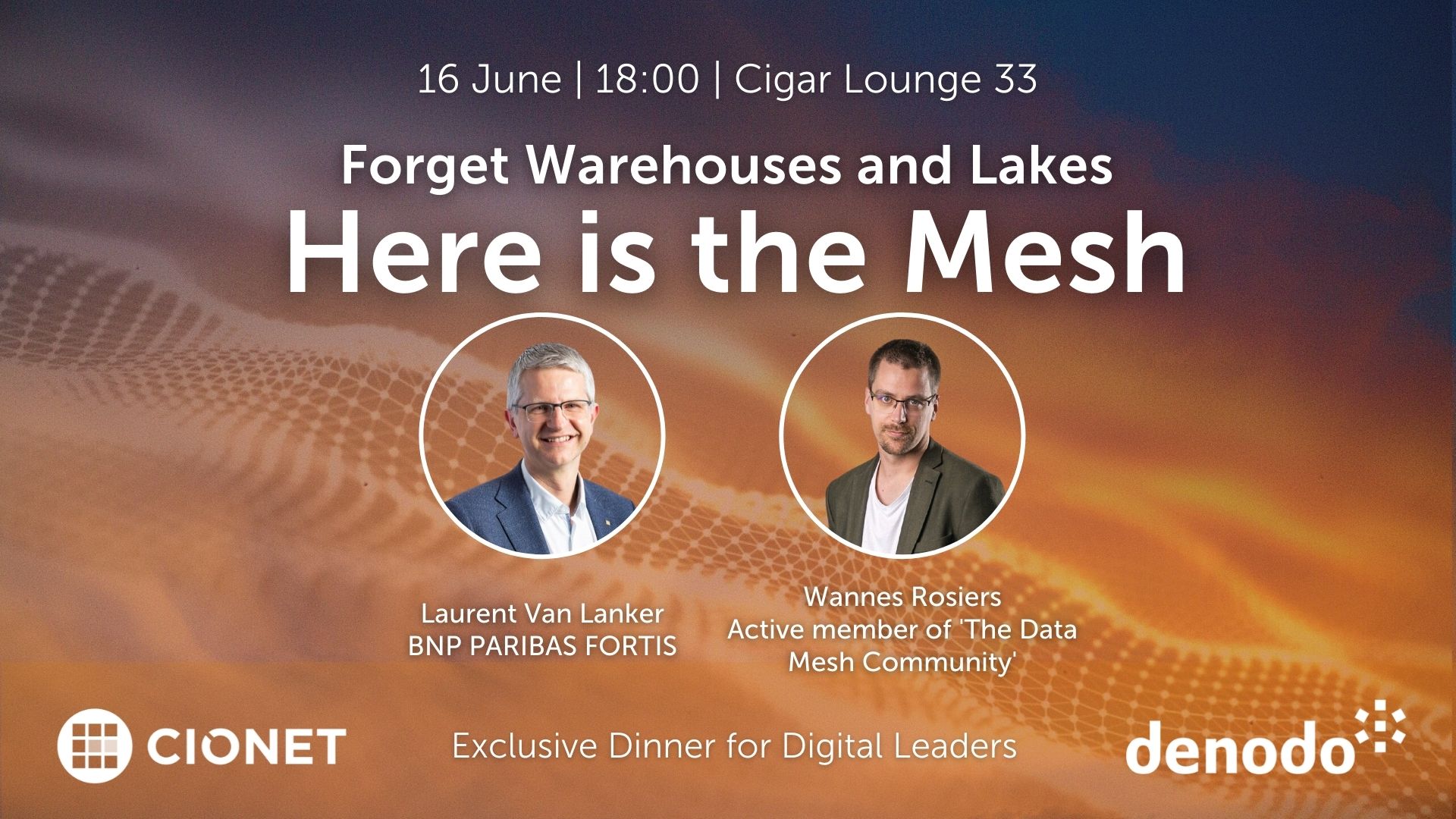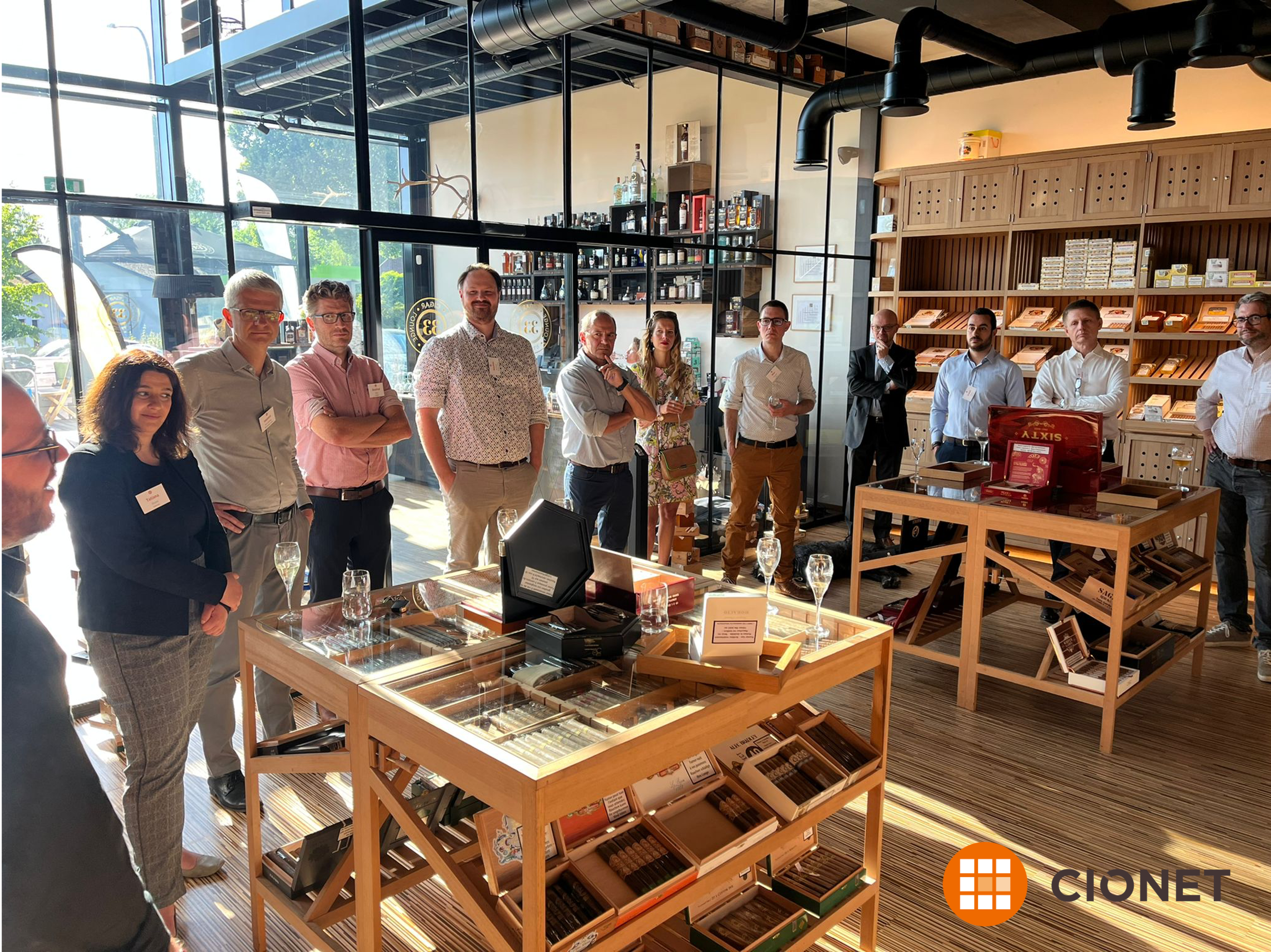EVENT
The data mesh, an intriguing (new) concept
Review of the last CIONET round table on "the Data Mesh" concept.
June 30, 2022

Passion and professionalism. Those are the two words I would use to describe the manager of the Cigar Lounge 33, who welcomed our group of 12 CIOs and CDOs at his beautiful establishment in Sint Genesius Rode near Brussels. CIONET had set up this round table at the Cigar Lounge with Denodo – the specialist in data virtualisation – to talk about an intriguing (new) concept in the field of data management: the data mesh.
The aperitif was taken in the coolness and the overwhelming perfumes of the enormous cigar humidor on the ground floor. Afterwards, we went up a floor to brainstorm as a group about ‘the mesh’ in true English cigar club-style – including Chesterfield armchairs and exclusive cigars.
We invited two speakers: Laurent Van Lancker, CTO of BNP Paribas Fortis and Wannes Rosiers, author and active member of the Data Mesh Community in Belgium. Both were eager to share their experiences and vision and listen to the CIOs’ perceptions and ideas on this matter. Is the data mesh the ultimate solution for creating a future-proof data platform, for removing the bottlenecks of centralised data management and for clarifying once and for all the roles and responsibilities related to data? Or is it just a hype? A new buzzword? Old wines in new bottles? These were the critical questions on the table.

Why are you here?
The first question to all participants: why are you here? Are you mainly curious about the concept of the data mesh, or do you already have experience with it? And if so, where do you stand?
The response of the participants covered the whole range: from exploratory research to advanced implementation of decentralised data architecture. A first remarkable fact: several CIOs indicated that their data platforms are naturally evolving towards a decentralised architecture, which, even though it has most of the characteristics of a data mesh, is not always labelled as such. Second observation: everyone is working intensively on their data management systems. Why? Because of the exponential increase in the volumes of data and data sources (including IOT and smart machines), combined with the high(er) reporting requirements of their organisation that wants to work in a data-driven and, where possible, (near) real-time manner. A central data management team often lacks business knowledge regarding the data and, therefore, cannot provide the business with the reports or data analyses that are crucial for the organisation’s functioning. The fact that ‘old’ data that is often still on-premise must be combined with ‘new’ cloud-based data does not make things any easier.
Centralise to decentralise better
A storyline that recurred for many participants was the step from centralising the data for quality and control reasons to decentralising the data to the domains defined according to the business logic (lines of business, or specific teams or programmes).
It is clear that it is not (yet) clear.
When Wannes was asked to define the data mesh, he responded cryptically by saying that the problem to be solved is clear, while the solution is not clear (yet). The mission is to enable the entire company to work with all available data in an optimal way. The concept of the data mesh is therefore based on four principles: 1. Decentralising the ownership of data to the (business) domains; 2. Installing data as product; 3. Enabling working with data in self-service mode and 4. Installing federated governance (SLAs).
Wannes could refer to the projects he had set up at the DPG group in that context, where data was also centralised in a first phase to get rid of uncontrolled data multiplication. This was followed by decentralisation to two specific business domains – in their case the ‘subscription service’ versus the ‘user behaviour service’. Other domains such as marketing were subsequently added. Data catalogues were built. Data guilds were set up. And the different departments became customers of each other’s data. With this, a new role was born: the ‘data product owner’, responsible for the quality and availability of ‘his’ specific data offered in the data catalogue. One unified company-wide data model is, as a result, not always possible. After all, the data model is strongly linked to the specific business: in a group such as DPG, a customer of a television station is defined differently from a subscriber of a newspaper or magazine, for example. Although connections can be made, the data models may differ within the same organisation.
Data mesh at BNPParibasFortis
According to Laurent, the trigger to start working on the ‘data mesh’ project at BNPParibasFortis was the ‘Agile Transformation’ programme that started about four years ago. The objective of this project was to bring the business and IT closer together. They established a centre of expertise precisely to manage the business knowledge about the data. Squads of product owners were set up alongside process owners who wanted an end-to-end view of their process. The evolution towards domain-driven data management has thus shifted significantly. The platform that allows self-service is in place. Where initially, they worked with multiple data warehouses, at a specific moment, everything was brought together in one data architecture & governance umbrella. They then introduced technologies that made real-time analysis possible and opted for domain-driven rationalisation. According to Laurent, the essential benefit is realised when data ownership is transferred to the business.
Aligning (IT) with the business is seen by most participants as a crucial but also challenging part of the story. At Brussels Airport, for example, IT staff are sent out to the business to teach or help them use data. At Colruyt, the distinction is made between information that is the responsibility of the business and data that remains a matter of IT. According to the Engie fellowmen around the table, it is mainly a matter of cultural change to instil a data-driven mentality in the organisation, partly by ‘merging’ IT and the business.
Lessons learned
Setting up a data mesh solution is more than a technological project. As many have pointed out, it is best to start with the governance part, clarifying roles and responsibilities before tackling the technical side. The big revolution is in decentralisation, assigning data ownership to the business, which should lead to higher data quality and transparency. In fact, the budget should also follow the same path and go to where the value is created, namely to the business. IT and business, therefore, enter into a kind of customer-supplier relationship.
Moreover, data mesh is not a ready-made solution. It is a solution in full evolution and a journey for the organisation that has decided to create maximum value based on its data. But it is a very promising solution, as the participants’ reactions unanimously indicated.
By Daniel Eycken, COO CIONET